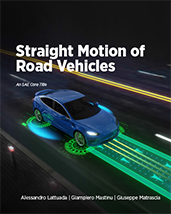Book

Straight Motion of Road Vehicles
2020-03-31
Straight Motion of Road Vehicles explores the straight motion of road vehicles with particular focus on the role played by tires, vehicle suspensions, and road cross slope. The authors consider vehicles currently in production as well as automated vehicles, which are likely to become more prevalent in the future. This work will lead to the production of safer, smarter, and more comfortable vehicles, enabling engineering solutions for vehicles that naturally run straight ahead, saving fuel and minimizing tire wear.
